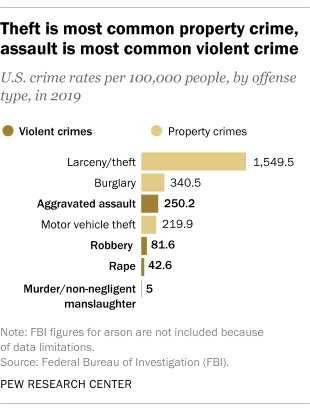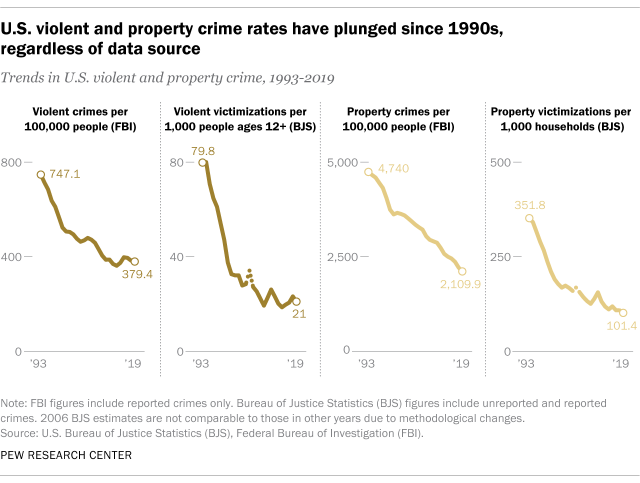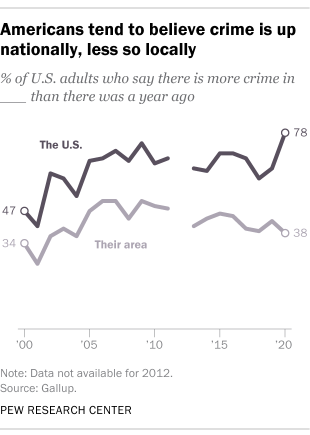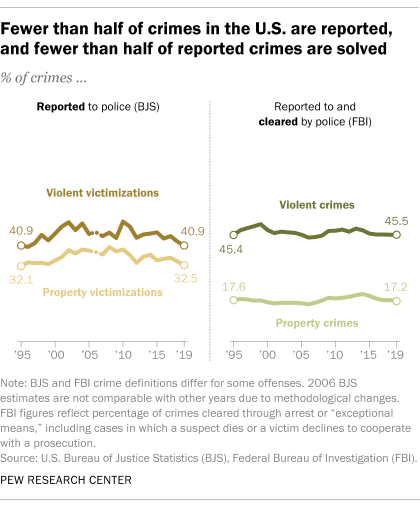From the first day of his presidency to his campaign for reelection, Donald Trump has sounded the alarm about crime in the United States. Trump vowed to end “American carnage” in his inaugural address in 2017. This year, he ran for reelection on a platform of “law and order.”
As Trump’s presidency draws to a close, here is a look at what we know – and don’t know – about crime in the U.S., based on a Pew Research Center analysis of data from the federal government and other sources.
Crime is a regular topic of discussion in the United States. We conducted this analysis to learn more about U.S. crime patterns and how those patterns have changed over time.
The analysis relies on statistics published by the Federal Bureau of Investigation (FBI) and the Bureau of Justice Statistics (BJS), the statistical arm of the U.S. Department of Justice. FBI statistics were accessed through the Crime Data Explorer. BJS statistics were accessed through the National Crime Victimization Survey data analysis tool. Information about the federal government’s transition to the National Incident-Based Reporting System was drawn from the FBI and BJS, as well as from media reports.
To measure public attitudes about crime in the U.S., we relied on survey data from Gallup and Pew Research Center.
How much crime is there in the U.S.?
It’s difficult to say for certain. The two primary sources of government crime statistics – the Federal Bureau of Investigation (FBI) and the Bureau of Justice Statistics (BJS) – both paint an incomplete picture, though efforts at improvement are underway.
The FBI publishes annual data on crimes that have been reported to the police, but not those that haven’t been reported. The FBI also looks mainly at a handful of specific violent and property crimes, but not many other types of crime, such as drug crime. And while the FBI’s data is based on information it receives from thousands of federal, state, county, city and other police departments, not all agencies participate every year. In 2019, the most recent full year available, the FBI received data from around eight-in-ten agencies.
BJS, for its part, tracks crime by fielding a large annual survey of Americans ages 12 and older and asking them whether they were the victim of a crime in the past six months. One advantage of this approach is that it captures both reported and unreported crimes. But the BJS survey has limitations of its own. Like the FBI, it focuses mainly on a handful of violent and property crimes while excluding other kinds of crime. And since the BJS data is based on after-the-fact interviews with victims, it cannot provide information about one especially high-profile type of crime: murder.
All those caveats aside, looking at the FBI and BJS statistics side-by-side does give researchers a good picture of U.S. violent and property crime rates and how they have changed over time.
Which kinds of crime are most and least common?
Property crime in the U.S. is much more common than violent crime. In 2019, the FBI reported a total of 2,109.9 property crimes per 100,000 people, compared with 379.4 violent crimes per 100,000 people.
By far the most common form of property crime in 2019 was larceny/theft, followed by burglary and motor vehicle theft. Among violent crimes, aggravated assault was the most common offense, followed by robbery, rape, and murder/non-negligent manslaughter.
BJS tracks a slightly different set of offenses from the FBI, but it finds the same overall patterns, with theft the most common form of property crime in 2019 and assault the most common form of violent crime.
How have crime rates in the U.S. changed over time?
Both the FBI and BJS data show dramatic declines in U.S. violent and property crime rates since the early 1990s, when crime spiked across much of the nation.
Using the FBI data, the violent crime rate fell 49% between 1993 and 2019, with large decreases in the rates of robbery (-68%), murder/non-negligent manslaughter (-47%) and aggravated assault (-43%). (It’s not possible to calculate the change in the rape rate during this period because the FBI revised its definition of the offense in 2013.) Meanwhile, the property crime rate fell 55%, with big declines in the rates of burglary (-69%), motor vehicle theft (-64%) and larceny/theft (-49%).
Using the BJS statistics, the declines in the violent and property crime rates are even steeper than those reported by the FBI. Per BJS, the overall violent crime rate fell 74% between 1993 and 2019, while the property crime rate fell 71%.
How do Americans perceive crime in their country?
Americans tend to believe crime is up, even when the data shows it is down.
In 20 of 24 Gallup surveys conducted since 1993, at least 60% of U.S. adults have said there is more crime nationally than there was the year before, despite the generally downward trend in national violent and property crime rates during most of that period.
While perceptions of rising crime at the national level are common, fewer Americans believe crime is up in their own communities. In all 23 Gallup surveys that have included the question since 1993, no more than about half of Americans have said crime is up in their area compared with the year before.
This year, the gap between the share of Americans who say crime is up nationally and the share who say it is up locally (78% vs. 38%) is the widest Gallup has ever recorded.
Public attitudes about crime also differ by Americans’ partisan affiliation, race and ethnicity and other factors. For example, in a summer Pew Research Center survey, 74% of registered voters who support Trump said violent crime was “very important” to their vote in this year’s presidential election, compared with a far smaller share of Joe Biden supporters (46%).
How does crime in the U.S. differ by demographic characteristics?
There are some demographic differences in both victimization and offending rates, according to BJS.
In its 2019 survey of crime victims, BJS found wide differences by age and income when it comes to being the victim of a violent crime. Younger people and those with lower incomes were far more likely to report being victimized than older and higher-income people. For example, the victimization rate among those with annual incomes of less than $25,000 was more than twice the rate among those with incomes of $50,000 or more.
There were no major differences in victimization rates between male and female respondents or between those identified as White, Black or Hispanic. But the victimization rate among Asian Americans was substantially lower than among other racial and ethnic groups.
When it comes to those who commit crimes, the same BJS survey asks victims about the perceived demographic characteristics of the offenders in the incidents they experienced. In 2019, those who are male, younger people and those who are Black accounted for considerably larger shares of perceived offenders in violent incidents than their respective shares of the U.S. population. As with all surveys, however, there are several potential sources of error, including the possibility that crime victims’ perceptions are incorrect.
How does crime in the U.S. differ geographically?
There are big differences in violent and property crime rates from state to state and city to city.
In 2019, there were more than 800 violent crimes per 100,000 residents in Alaska and New Mexico, compared with fewer than 200 per 100,000 people in Maine and New Hampshire, according to the FBI.
Even in similarly sized cities within the same state, crime rates can vary widely. Oakland and Long Beach, California, had comparable populations in 2019 (434,036 vs. 467,974), but Oakland’s violent crime rate was more than double the rate in Long Beach. The FBI notes that various factors might influence an area’s crime rate, including its population density and economic conditions.
See also: Despite recent violence, Chicago is far from the U.S. ‘murder capital’
What percentage of crimes are reported to police, and what percentage are solved?
Most violent and property crimes in the U.S. are not reported to police, and most of the crimes that are reported are not solved.
In its annual survey, BJS asks crime victims whether they reported their crime to police or not. In 2019, only 40.9% of violent crimes and 32.5% of household property crimes were reported to authorities. BJS notes that there are a variety of reasons why crime might not be reported, including fear of reprisal or “getting the offender in trouble,” a feeling that police “would not or could not do anything to help,” or a belief that the crime is “a personal issue or too trivial to report.”
Most of the crimes that are reported to police, meanwhile, are not solved, at least based on an FBI measure known as the clearance rate. That’s the share of cases each year that are closed, or “cleared,” through the arrest, charging and referral of a suspect for prosecution, or due to “exceptional” circumstances such as the death of a suspect or a victim’s refusal to cooperate with a prosecution. In 2019, police nationwide cleared 45.5% of violent crimes that were reported to them and 17.2% of the property crimes that came to their attention. Both the percentage of crimes that are reported to police and the percentage that are solved have remained relatively stable for decades.
Which crimes are most likely to be reported to police, and which are most likely to be solved?
Around eight-in-ten motor vehicle thefts (79.5%) were reported to police in 2019, making it by far the most commonly reported property crime tracked by BJS. Around half (48.5%) of household burglary and trespassing offenses were reported, as were 30% of personal thefts/larcenies and 26.8% of household thefts.
Among violent crimes, aggravated assault was the most likely to be reported to law enforcement (52.1%). It was followed by robbery (46.6%), simple assault (37.9%) and rape/sexual assault (33.9%).
The list of crimes cleared by police in 2019 looks different from the list of crimes reported. Law enforcement officers were generally much more likely to solve violent crimes than property crimes, according to the FBI.
The most frequently solved violent crime tends to be homicide. Police cleared around six-in-ten murders and non-negligent manslaughters (61.4%) last year. The clearance rate was lower for aggravated assault (52.3%), rape (32.9%) and robbery (30.5%).
When it comes to property crime, law enforcement agencies cleared 18.4% of larcenies/thefts, 14.1% of burglaries and 13.8% of motor vehicle thefts.
Is the government doing anything to improve its crime statistics?
Yes. The FBI has long recognized the limitations of its current data collection system and is planning to fully transition to a more comprehensive system beginning in 2021.
The new system, known as the National Incident-Based Reporting System (NIBRS), will provide information on a much larger number of crimes, as well as details such as the time of day, location and types of weapons involved, if applicable. It will also provide demographic data, such as the age, sex, race and ethnicity of victims, known offenders and arrestees.
One key question looming over the transition is how many police departments will participate in the new system, which has been in development for decades. In 2019, the most recent year available, NIBRS received violent and property crime data from 46% of law enforcement agencies, covering 44% of the U.S. population that year. Some researchers have warned that the transition to a new system could leave important data gaps if more law enforcement agencies do not submit the requested information to the FBI.

"center" - Google News
November 21, 2020 at 12:48AM
https://ift.tt/3nD3308
Crime in the US: Key questions answered - Pew Research Center
"center" - Google News
https://ift.tt/3bUHym8
https://ift.tt/2zR6ugj
Bagikan Berita Ini




















0 Response to "Crime in the US: Key questions answered - Pew Research Center"
Post a Comment